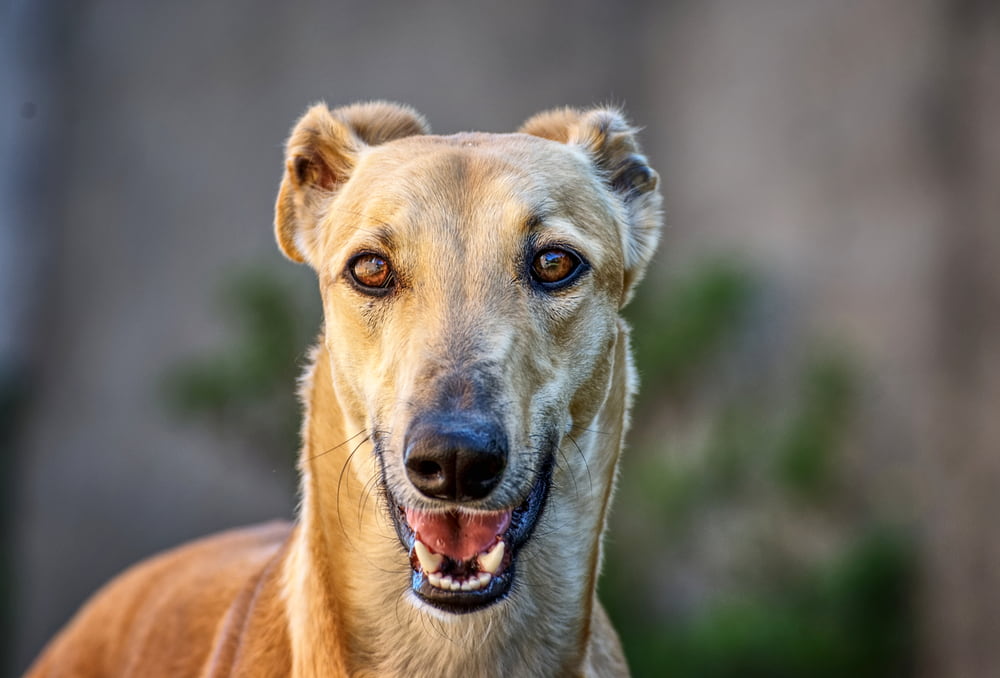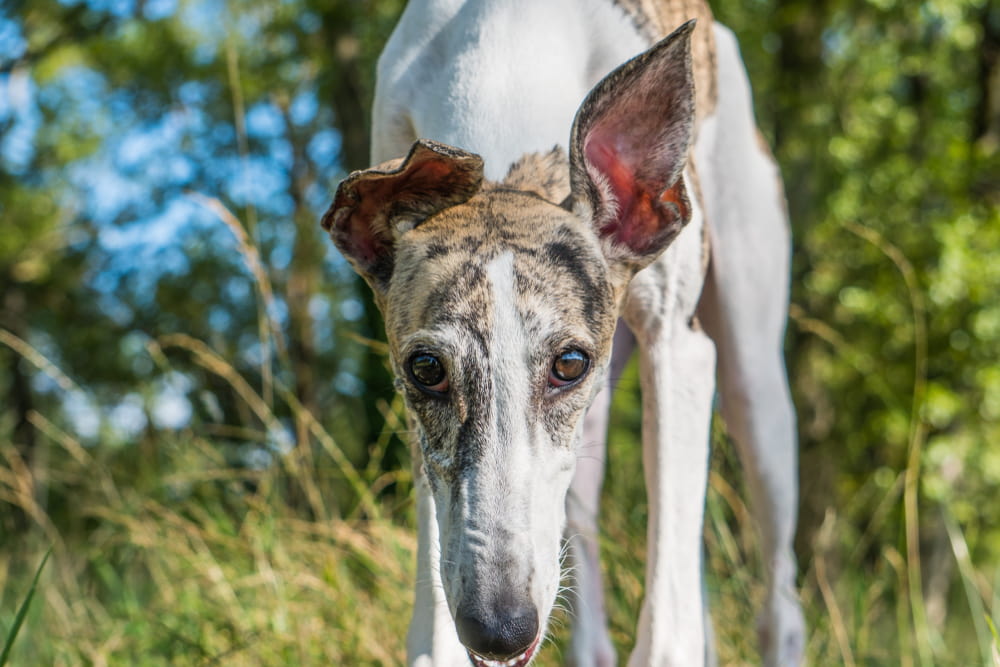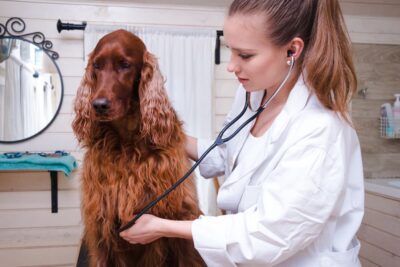Greyhound

Breed Details
- Average Height: 27-30 inches
- Average Weight: 50-80 lbs
- Coloring: Brindle (tan or brown with black striping), black, fawn, red, among others
- Coat Type: Short and smooth hair without an undercoat
- Dog Breed Group: Hound Group
- Average Lifespan: 10-13 years
-
Key Personality Traits:
Affectionate
Good with Kids
Intelligent
Docile
The graceful and intelligent Greyhound is among the oldest and fastest dog breeds in the world. With a lithe figure, aerodynamic head, sleek fur, and long legs, these canines were bred for coursing, the art of hunting game animals with sight rather than smell.
For nearly a century, Greyhounds have been bred and trained for commercial track racing, giving them a false impression that they are aggressive, high strung, and unloving. This couldn’t be farther from the truth. These gentle animals are giant lap dogs, wanting nothing more than to curl up on the couch with their humans.
According to the Humane Society, Greyhound racing, which began in the United States in the early 20th century, is on the decline. It is now illegal in 41 states and is projected to disappear in the next few years. Racing Greyhounds face inhumane and cruel conditions. Thankfully, there’s been a strong movement to protect these animals and place them in loving homes, where they can live out their lives in peace.
A majority of Greyhounds currently in homes are former racing dogs who were either past their prime or lost too many races.
History and Origin

The Greyhound is an ancient dog breed dating back to 4,000 BC. They are believed to have originated in the Middle East, “Dogs resembling Greyhounds have been found on the walls of Ancient Egyptian tombs,” writes Derek Hall in The Ultimate Guide to Dog Breeds.
From Egypt, Greyhounds were brought by traders to Europe, Asia, and Britain, and by Spaniards to the new world in the 1500s. In the United States, they became popular during Colonial times among Midwestern farmers for chasing crop-destroying rabbits.
These sprinters belong to the sighthounds or gazehound hound group, which are bred primarily to hunt using their sight and speed, rather than by scent. During the middle ages, they nearly became extinct and were saved by the clergymen and bred for nobility. In England, they became aristocratic dogs and were used in the sport of coursing to hunt hare. Hall states that the breed developed to the current standard in Britain.
Today, there are three different kinds of Greyhound lines: those that are bred for racing, coursing, and showing. The AKC (American Kennel Club) recognized the breed in 1885.
Greyhound Physical Characteristics

A slender muscular build, broad skull with a long muzzle, dark eyes, a long neck, a gently curving deep chest, small waist, and gracefully long legs define the Greyhound’s signature look.
Females can weigh anywhere from 50 to 65 pounds and males from 65-80 pounds. They can reach a height of up to 30 inches to the shoulder. Their coat is short and the colors vary from brindle, black, and white to red and fawn. They reach adulthood in about 18 months.
Italian Greyhounds, the miniature version of Greyhounds, grow to be 15 inches tall and weigh 6-10 lbs. These fragile-seeming, yet energetic hounds have satin-like, fine coats and come in similar colors as the larger sighthounds.
Greyhound Temperament

If you are looking for an active dog that can also be a couch potato, the Greyhound is a perfect fit. “They are sweet, affectionate, even-tempered, loyal, intelligent and easy to train,” says Dr. Shadi Ireifej, co-founder and chief medical officer at VetTriage.
One of the most positive things about this breed is that they can “live in various household living spaces,” according to Ireifej. “They are a great breed for first-time dog owners and can sleep up to 20 hours a day,” he says. These dogs rarely bark, making them ideal partners for apartment life.
As for cons, Ireifej says “they can be high anxiety and very sensitive.” Greyhounds need to be handled compassionately in a quiet environment (free of any loud noises). Proper positive training can also help them become more relaxed. Additionally, they may be aloof with people they don’t know, so gentle introductions and early socialization are needed.
If you have a family with kids, Greyhounds make great companions. “They love to herd and will always keep an eye on the children,” says Dr. Sara Ochoa of Whitehouse Veterinary Hospital in Texas.
Because Greyhounds, especially those that have been trained to race, are used to spending time with other dogs, they can be good with other pets at home, so long as the others are non-aggressive.
Greyhound Care Guide

Similar to other dog breeds, Greyhounds need regular veterinary checkups and immunizations. However, unlike most other breeds, these champion runners have a different body type and exercise needs, and special attention needs to be given to ensure they remain healthy and happy.
Diet and Nutrition
A quality diet is necessary for a Greyhound’s health. “They can easily become overweight if they are fed too much,” says Ochoa. “It is best to feed them a high-quality diet twice a day rather than free feeding them.”
Additionally, a busy bowl or a high feeder can help Greyhounds reach their food without causing bloat, a dangerous health condition.
Exercise and Activity
Traditionally, Greyhounds were used for hunting and they possess a high prey drive. This means they need ample playtime to keep them stimulated and in good health. “They are athletic so an active lifestyle is in their genes,” says Ireifej. “They need two 30-minute exercise sessions daily.”
Ochoa says that Greyhounds enjoy participating in agility and other dog sporting events. They also make great jogging companions. “This makes this breed great for an active family,” she says.
Although the Greyhound is capable of living happily in an apartment, he would greatly benefit from having large spaces to run around and expend his energy. Provide proper training early on to ensure your dog knows recall, which will come in handy if he gets distracted by any small animals while on a walk. Never let your Greyhound run without supervision.
Grooming and Nail Care
Greyhounds are low maintenance dogs and don’t require a big time commitment for grooming. Because they have short light fur without an undercoat, they don’t need to be professionally groomed.
“Greyhounds do not need to be groomed but they do shed,” says Ochoa. “They will need a bath every few weeks at most.”
Pet parents could also use a grooming glove to remove dead hair. Similar to other dogs, Greyhounds benefit from having their nails trimmed once a month.
Additional Greyhound Care
The Greyhound’s lean body means low body fat, making them feel uncomfortable on hard surfaces. These dogs are also not capable of sitting on their rear-end like other dogs, and tend to go into a stay position.
Make sure to provide them with comfortable beds or allow them on couches to rest. If you’ve got a king bed, don’t be surprised if your furry fellow takes up space roaching (an adorable position in which they turn upside down on their back, with their legs dangling in the air).
Take additional care of your Greyhound during warm and cold weather conditions. Due to the dog’s low body fat, he may be vulnerable to extreme cold or hot conditions. Be sure to put on sweaters or coats in the winter and shorten time spent outdoors in both winter and summer.
Greyhound Health Issues

Due to their genetics and build, Greyhounds are prone to a few health conditions. These include:
Bloat: Due to their deep chests, Greyhounds may develop bloat, which is a dangerous and potentially life-threatening condition when the stomach becomes swollen with food or gas. Ochoa recommends allowing your Greyhound to rest after eating to decrease the chance of bloat.
Hypothyroidism: Hypothyroidism “is usually caused by inflammation or shrinkage of the thyroid gland,” according to Washington State University. Low thyroid function results in weight gain, skin infections, thinning of the fur, excessive shedding, reduced activity and lower tolerance to the cold. This is a highly treatable disease, which involves giving the pet an oral replacement hormone daily.
Osteosarcoma: This type of bone cancer is a malignant tumor that happens due to abnormal cell production and the breakdown of bone. Dogs with osteosarcoma may experience lameness or swelling around the tumor. When caught early, the tumor can be removed to prevent amputation of the affected limb.
Musculoskeletal Injuries: Since Greyhounds are active dogs, they are also prone to musculoskeletal injuries, according to Ireifej. Feeding Greyhounds a complete and balanced diet and supervising them when active can help prevent injuries.
Interesting Greyhound Facts

From being the only dog breed named in the Bible to appearing in Renaissance paintings and modern-day TV shows, this long-lived breed has been a popular figure throughout history. Read on to find out interesting facts about the Greyhound.
Greyhounds have a 270-degree field of vision. This is due to the narrow shape of their head. They can see behind them!
The Greyhound is the only dog breed appearing by name in the Bible, in the King James Version, Proverbs, 30:29-31 (A greyhound; and he goat also; and a king, against whom there is no rising up.).
The elegant Greyhound appears in Renaissance paintings by artists like Veronese and Desportes in hunting settings.
General George Custer, who died in the Battle of the Big Horn, was a big fan of Greyhound and often traveled with them on missions.
The cartoon character, Santa’s Little Helper, appearing in the first episode of the TV Series, The Simpsons, is a Greyhound rescued from a race track.
Popular Greyhound Mixes
Here are some of the most common Greyhound mixed breeds.
Greyhuahua is an offspring of purebred spunky Chihuahua and the graceful Italian Greyhound.
Greyhound Husky Mix, as the name implies is a blend of Greyhound and the gorgeous Husky.
Corgi Greyhound Mix is a result of breeding the Greyhound with the fun-loving Corgi.
Greybull Pit is an adorable descendant of the Greyhound and the loving American Pit Bull Terrier.
Greyhound Shepherd is a hybrid of Greyhound and the obedient German Shepherd.
Doberman Greyhound is an athletic dog resulting from the combination of Doberman and Greyhound.
Greyador sounds like an animal from Game of Thrones, but is in fact, is a mix of the popular Labrador Retriever and the Greyhound.
Greyhound Adoption Tips and Things to Consider

If you are considering giving a loving home to a retired racing Greyhound, there are a number of rescues working tirelessly to help the breed. Rescues work with trainers and owners looking to find private homes for former racing Greyhounds. These rescues also take in Greyhounds that have been surrendered to shelters.
Although these dogs have been around other dogs and people their entire lives, they aren’t accustomed to homes. Things like vacuum cleaners, slippery wooden floors, door bells, and even car rides could scare them. When bringing home your Greyhound, introduce him to new sounds and experiences gradually.
The right rescue can help match you with the perfect Greyhound for your family. Below are a few Greyhound rescues to consider to find your next loyal buddy.
- G.R.E.A.T (Greyhounds Rescue and Adoptions of Tampa Bay)
- Kansas City REGAP (Retired Greyhounds As Pets)
- Greyhound Rescue of Idaho
- American Greyhound
Greyhound FAQs

If you are thinking about bringing a Greyhound into your life, it’s helpful to have all of the information you need about these large and elegant dogs. We’ve provided answers to some frequently asked Greyhound questions.
How Fast Can a Greyhound Run?
These dogs are speedy! Greyhounds can run up to 45 miles per hour.
Do Greyhounds Shed?
Yes, Greyhounds do shed, but it can be managed by regular brushing. Greyhounds don’t have an undercoat, making their shedding less of a problem than other breeds.
Are Greyhounds Hypoallergenic?
No, despite their lack of undercoat, Greyhounds can still cause allergies.
How Long Do Greyhounds Live?
For a larger breed, Greyhounds have a decent lifespan. They can live up to 10 to 13 years.
Are Greyhounds Good With Kids?
These docile pets are great with kids. However, similar to other furry companions, supervision is needed when your dog is around little ones.
Greyhound Pictures
If you want to see Greyhounds in action (and being adorable couch potatoes) browse through our gallery of Greyhound pictures to see the variety, coloring, and cuteness of these amazing dogs.




















